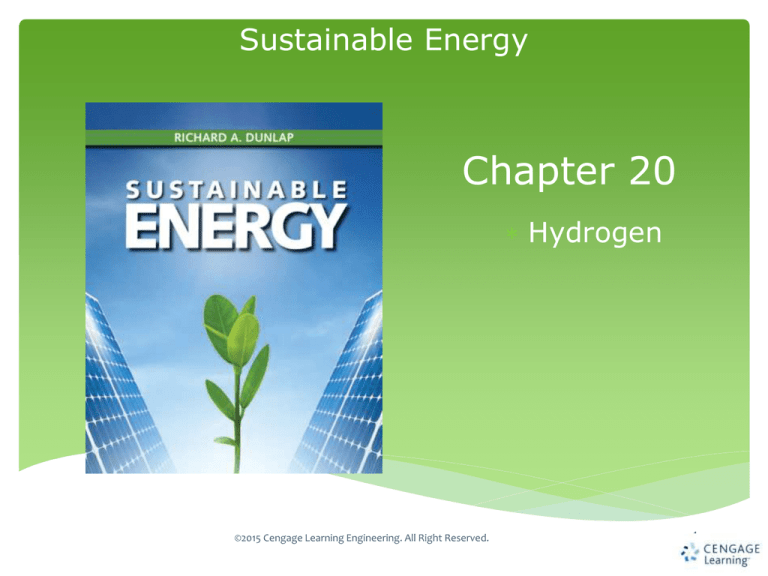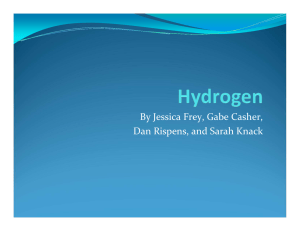
Sustainable Energy
Chapter 20
Hydrogen
©2015 Cengage Learning Engineering. All Right Reserved.
1
Sustainable Energy
Dunlap
Learning Objectives
●
●
●
●
●
●
●
The basic properties of hydrogen as a gas and as a
liquid.
Methods for hydrogen production.
The factors that must be considered when storing
gaseous or liquid hydrogen.
The use of hydrogen as a fuel in internal
combustion engines.
The properties and types of fuel cells.
The design of fuel cell vehicles.
The viability of hydrogen as a fuel and efficiency
considerations for its use.
©2015 Cengage Learning Engineering. All Right Reserved.
2
Sustainable Energy
Dunlap
Hydrogen
Hydrogen is a mechanism for storing energy and is not a
primary energy source like oil.
Hydrogen is produced by certain endothermic chemical
processes by supplying energy.
The energy supplied to produce the hydrogen can be
recovered by burning the hydrogen or reacting it in a fuel cell.
©2015 Cengage Learning Engineering. All Right Reserved.
3
Sustainable Energy
Dunlap
The combustion of hydrogen
The combustion of hydrogen produces water and heat
according to the reaction
The energy produced by burning hydrogen is compared with
that from burning gasoline.
©2015 Cengage Learning Engineering. All Right Reserved.
4
Sustainable Energy
Dunlap
Comparison of hydrogen energy
with other transportation fuels
©2015 Cengage Learning Engineering. All Right Reserved.
5
Sustainable Energy
Dunlap
Production of hydrogen
Hydrogen can be produced by several methods:
•
•
•
•
Electrolysis
Thermal decomposition of water
Chemical reactions
Biological processes
©2015 Cengage Learning Engineering. All Right Reserved.
6
Sustainable Energy
Dunlap
Electrolysis
Electrolysis is the reduction of water according to the reaction
Typically energy is supplied by an electric current
Electrolysis is typically about 70% efficient
©2015 Cengage Learning Engineering. All Right Reserved.
7
Sustainable Energy
Dunlap
Electrolysis cell
Electrical conductivity of the water is typically increased by
dissolving an ionic compound
©2015 Cengage Learning Engineering. All Right Reserved.
8
Sustainable Energy
Dunlap
Thermal decomposition of water
Decomposition of water can be accomplished using thermal
rather than electrical energy - Typically a catalyst facilitates
the process.
Typical thermal decomposition reaction
Begin by heating sulfuric acid
Combine the sulfur dioxide with iodine and water
Hydrogen iodide is decomposed to produce hydrogen
©2015 Cengage Learning Engineering. All Right Reserved.
9
Sustainable Energy
Dunlap
Chemical reactions
Hydrogen can be produced by high temperature reactions
involving water such as the reaction of water with methane
Or the reaction of with carbon
©2015 Cengage Learning Engineering. All Right Reserved.
10
Sustainable Energy
Dunlap
Biological processes
Certain biological process may produce
hydrogen as a by-product.
Research is required to develop efficient and
environmentally conscientious processes.
©2015 Cengage Learning Engineering. All Right Reserved.
11
Sustainable Energy
Dunlap
Hydrogen storage
Because hydrogen has a very low density, its volume
must be reduced in order to store and transport it
efficiently.
Methods for hydrogen storage
• Compressed hydrogen gas
• Liquid hydrogen
• Metal hydrides
©2015 Cengage Learning Engineering. All Right Reserved.
12
Sustainable Energy
Dunlap
Density pressure relationship
©2015 Cengage Learning Engineering. All Right Reserved.
13
Sustainable Energy
Dunlap
Ideal gas law
At low pressures hydrogen follows the ideal gas law
or
As the density increases atom-atom interactions cause the
ideal gas law to break down and the density does not
increase with pressure as rapidly.
©2015 Cengage Learning Engineering. All Right Reserved.
14
Sustainable Energy
Dunlap
Liquid hydrogen
Hydrogen may be liquefied by lowering the
temperature below 20.3 K.
The density of LH2 is greater than the density of
CHG at any pressure.
©2015 Cengage Learning Engineering. All Right Reserved.
15
Sustainable Energy
Dunlap
Hydrogen spin states
The spins of the spins of the nuclei (protons) of the hydrogen
atoms in a hydrogen molecule can align antiparallel or
parallel.
©2015 Cengage Learning Engineering. All Right Reserved.
16
Sustainable Energy
Dunlap
Ground and excited hydrogen states
The antiparallel alignment (parahydrogen) is the ground
state and the parallel alignment (orthohydrogen) is the
excited state.
At room temperature thermal energy causes a mixture of
about 20% parahydrogen and 75% orthohydrogen.
Cooling the hydrogen quickly to the liquid state yields a
non-equilibrium excess population of orthohydrogen
The orthohydrogen gradually converts to parahydrogen,
giving up energy and causing some of the hydrogen to boil
away.
Catalysts can be used to avoid this situation.
©2015 Cengage Learning Engineering. All Right Reserved.
17
Sustainable Energy
Dunlap
Loss rate of liquid hydrogen
The loss rate decreases with increasing tank size (due to
decreasing surface to volume ratio)
©2015 Cengage Learning Engineering. All Right Reserved.
18
Sustainable Energy
Dunlap
Metal hydrides
Hydrogen can be stored in a metal by the formation a
metal hydride
A common metal for this process is Ti yielding TiH2
Drawbacks of this approach are
• Difficult to get hydrogen into and out of metal quickly
• Excessive weight of metal
©2015 Cengage Learning Engineering. All Right Reserved.
19
Sustainable Energy
Dunlap
Comparison of different hydrogen
storage mechanisms
©2015 Cengage Learning Engineering. All Right Reserved.
20
Sustainable Energy
Dunlap
Hydrogen internal combustion vehicles
Internal combustion vehicles using hydrogen as a fuel are
being investigated by BMW and Mazda.
These use modified gasoline engines and are dual-fuel
(hydrogen-gasoline).
They use different approaches to fuel storage.
©2015 Cengage Learning Engineering. All Right Reserved.
21
Sustainable Energy
Dunlap
BMW Hydrogen 7
©2015 Cengage Learning Engineering. All Right Reserved.
22
Sustainable Energy
Dunlap
Mazda RX-8 RE
©2015 Cengage Learning Engineering. All Right Reserved.
23
Sustainable Energy
Dunlap
Fuel cells
Fuel cells combine hydrogen and oxygen and produce electricity
directly without combustion
Air typically used as the source of oxygen
©2015 Cengage Learning Engineering. All Right Reserved.
24
Sustainable Energy
Dunlap
Operation of a fuel cell
Hydrogen is ionized at the anode by the reaction
The two excess electrons travel through the external circuit
to react with oxygen at the cathode
Water is formed in the electrolyte by the reaction
©2015 Cengage Learning Engineering. All Right Reserved.
25
Sustainable Energy
Dunlap
Types of fuel cells
Different fuel cell designs use different electrolytes and are
suitable for different applications
©2015 Cengage Learning Engineering. All Right Reserved.
26
Sustainable Energy
Dunlap
Phosphoric acid fuel cells
Earliest design of fuel cells from mid-1800s
• Low power density
• Relatively low efficiency
• Good for stationary applications to produce
backup emergency electricity
©2015 Cengage Learning Engineering. All Right Reserved.
27
Sustainable Energy
Dunlap
Alkaline fuel cells
•
•
•
•
•
High efficiency
Small size
Expensive
Produces drinkable water
Used by NASA on spacecraft
©2015 Cengage Learning Engineering. All Right Reserved.
28
Sustainable Energy
Dunlap
Molten carbonate and
solid oxide fuel cells
Similar operating characteristics
• Need to be operated at high temperature
• Can use methane (natural gas) as a source
of hydrogen
• Emits CO2 when running on methane
©2015 Cengage Learning Engineering. All Right Reserved.
29
Sustainable Energy
Dunlap
Solid polymer fuel cells
•
•
•
•
•
High power density
High efficiency
Operates at low temperature
Good range of power output for vehicle use
Used almost exclusively for vehicles
©2015 Cengage Learning Engineering. All Right Reserved.
30
Sustainable Energy
Dunlap
Fuel cell vehicles
Many automobile manufacturers developing fuel
cell vehicles.
These vehicles use electricity produced from
hydrogen to run electric motors and are
"hybrids" using batteries or supercapacitors as
an additional energy source.
©2015 Cengage Learning Engineering. All Right Reserved.
31
Sustainable Energy
Dunlap
Comparison of some fuel cell vehicles
©2015 Cengage Learning Engineering. All Right Reserved.
32
Sustainable Energy
Dunlap
Kia Borgeo fuel cell SUV
©2015 Cengage Learning Engineering. All Right Reserved.
33
Sustainable Energy
Dunlap
Hydrogen infrastructure
Use of fuel cell vehicles
requires the
commercial availability
of hydrogen
World's first hydrogen
fueling station in
Iceland
©2015 Cengage Learning Engineering. All Right Reserved.
34
Sustainable Energy
Dunlap
Hydrogen fueling stations in NW U.S.
and SW Canada
©2015 Cengage Learning Engineering. All Right Reserved.
35
Sustainable Energy
Dunlap
Hydrogen fueling stations in Europe
©2015 Cengage Learning Engineering. All Right Reserved.
36
Sustainable Energy
Dunlap
Transportation efficiencies
Four possible transportation technologies have
been considered in detail
•
•
•
•
Fossil fuel ICE vehicles (e.g. gasoline)
Battery electric vehicles
Hydrogen ICE vehicles
Hydrogen fuel cell vehicles
©2015 Cengage Learning Engineering. All Right Reserved.
37
Sustainable Energy
Dunlap
Analysis of net efficiency
Gasoline ICEs
Fossil fuel burned to produce mechanical energy in a
heat engine
©2015 Cengage Learning Engineering. All Right Reserved.
38
Sustainable Energy
Dunlap
BEVs
As most electricity (at least in the U.S.) is produced by
burning fossil fuels, the net efficiency from primary energy
source to mechanical energy (at the wheels) can be
analyzed.
©2015 Cengage Learning Engineering. All Right Reserved.
39
Sustainable Energy
Hydrogen ICEs
Dunlap
Following the energy conversion steps from primary
energy to mechanical energy for a hydrogen ICE
vehicle
©2015 Cengage Learning Engineering. All Right Reserved.
40
Sustainable Energy
Dunlap
Fuel cell vehicle
Efficiency analysis for a hydrogen fuel cell vehicle
©2015 Cengage Learning Engineering. All Right Reserved.
41
Sustainable Energy
Dunlap
Summary of efficiencies
• BEVs about twice typical gasoline vehicle
• Fuel cell vehicle similar to gasoline vehicle
• Hydrogen ICE substantially lower than
gasoline
©2015 Cengage Learning Engineering. All Right Reserved.
42
Sustainable Energy
Dunlap
Carbon footprint analysis
Current U.S. electricity production methods
©2015 Cengage Learning Engineering. All Right Reserved.
43
Sustainable Energy
Dunlap
Carbon production per unit energy
for different fossil fuels
Note: The combustion of carbon produces energy by the
production of CO2
The combustion of a hydrocarbon produces energy by the
combustion of carbon to produce CO2 and the combustion of
hydrogen to produce H2O
©2015 Cengage Learning Engineering. All Right Reserved.
44
Sustainable Energy
Dunlap
Carbon footprint analysis
Using current U.S. electricity generation
©2015 Cengage Learning Engineering. All Right Reserved.
45
Sustainable Energy
Dunlap
Summary
• Hydrogen is an energy storage mechanism not a primary
energy source
• Most commonly produced by electrolysis of water
• Hydrogen has a very high energy content per unit mass
• Its low density makes storage and transportation a
challenge
• Can be stored as CHG, LH2 or as a metal hydride
• CHG is the most common approach to storage
• Hydrogen ICE and fuel cell vehicles are under development
• Hydrogen ICE vehicles have low net efficiency and large
carbon footprint
• Fuel cell vehicles are similar to gasoline vehicles in
efficiency and carbon footprint
©2015 Cengage Learning Engineering. All Right Reserved.
46







